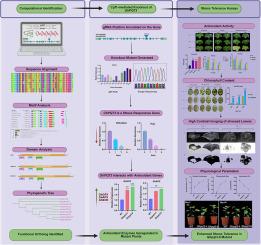Functional characterization of Arabidopsis PQT3 homolog in cotton reveals as a potential candidate for redox homeostasis and abiotic stress resistance
IF 6.8
Q1 PLANT SCIENCES
引用次数: 0
Abstract
Abiotic stresses like drought and salinity severely impact cotton productivity by triggering excessive accumulation of reactive oxygen species (ROS), leading to oxidative damage. In this study, we functionally characterized GhPQT3, a homolog of Paraquat tolerance 3 from the Arabidopsis thaliana E3 ligase family, and its role in regulating oxidative stress responses. Computational analysis identified two GhPQT3 homologs in the Gossypium hirsutum, showing high sequence conservation with Arabidopsis and rice PQT3. Protein sequence alignment, phylogenetic analysis, conserved motif, and domain annotation confirmed that GhPQT3 shares structural and functional similarity with its dicot homologs. CRISPR-Cas12 mediated knock out mutants were generated for functional characterization of the protein. Functional studies revealed that GhPQT3 acts as a negative regulator of antioxidant defenses, and its suppression in mutant lines Ghpqt3–4 and Ghpqt3–6 significantly enhanced tolerance to drought and salinity. These mutant lines exhibited elevated gene expression and enzymatic activity of APX and GPX especially Ghpqt3–6, which consistently maintained higher antioxidant activity and reduced oxidative damage. The DPPH radical scavenging assay, quantification of chlorophyll content and leaf necrosis further confirmed improved cellular integrity, improved redox homeostasis. These findings establish GhPQT3 as a promising target for genetic improvement, offering a robust strategy to develop stress-resilient cotton cultivars capable of withstanding climate-induced abiotic stresses.

拟南芥PQT3同源基因在棉花中的功能研究揭示了其作为氧化还原稳态和非生物抗逆性的潜在候选基因
干旱和盐度等非生物胁迫通过引发活性氧(ROS)的过度积累,导致氧化损伤,严重影响棉花产量。在本研究中,我们对拟南芥E3连接酶家族中百草枯耐受3的同源基因GhPQT3及其在调节氧化应激反应中的作用进行了功能表征。计算分析发现,棉中有两个GhPQT3同源基因,与拟南芥和水稻的PQT3序列高度保守。蛋白质序列比对、系统发育分析、保守基序和结构域注释证实,GhPQT3与其双同源物具有结构和功能相似性。生成了CRISPR-Cas12介导的敲除突变体,以对该蛋白进行功能表征。功能研究表明,GhPQT3作为抗氧化防御的负调控因子,其抑制在突变系GhPQT3 - 4和GhPQT3 - 6中显著增强了对干旱和盐的耐受性。这些突变系APX和GPX的基因表达和酶活性均有所提高,尤其是Ghpqt3-6,保持了较高的抗氧化活性,减少了氧化损伤。DPPH自由基清除实验,叶绿素含量和叶片坏死的定量进一步证实了细胞完整性的改善,氧化还原稳态的改善。这些发现确立了GhPQT3作为一个有希望的遗传改良靶点,为开发能够抵御气候诱导的非生物胁迫的抗逆性棉花品种提供了强有力的策略。
本文章由计算机程序翻译,如有差异,请以英文原文为准。
求助全文
约1分钟内获得全文
求助全文
来源期刊

Plant Stress
PLANT SCIENCES-
CiteScore
5.20
自引率
8.00%
发文量
76
审稿时长
63 days
期刊介绍:
The journal Plant Stress deals with plant (or other photoautotrophs, such as algae, cyanobacteria and lichens) responses to abiotic and biotic stress factors that can result in limited growth and productivity. Such responses can be analyzed and described at a physiological, biochemical and molecular level. Experimental approaches/technologies aiming to improve growth and productivity with a potential for downstream validation under stress conditions will also be considered. Both fundamental and applied research manuscripts are welcome, provided that clear mechanistic hypotheses are made and descriptive approaches are avoided. In addition, high-quality review articles will also be considered, provided they follow a critical approach and stimulate thought for future research avenues.
Plant Stress welcomes high-quality manuscripts related (but not limited) to interactions between plants and:
Lack of water (drought) and excess (flooding),
Salinity stress,
Elevated temperature and/or low temperature (chilling and freezing),
Hypoxia and/or anoxia,
Mineral nutrient excess and/or deficiency,
Heavy metals and/or metalloids,
Plant priming (chemical, biological, physiological, nanomaterial, biostimulant) approaches for improved stress protection,
Viral, phytoplasma, bacterial and fungal plant-pathogen interactions.
The journal welcomes basic and applied research articles, as well as review articles and short communications. All submitted manuscripts will be subject to a thorough peer-reviewing process.
 求助内容:
求助内容: 应助结果提醒方式:
应助结果提醒方式:


